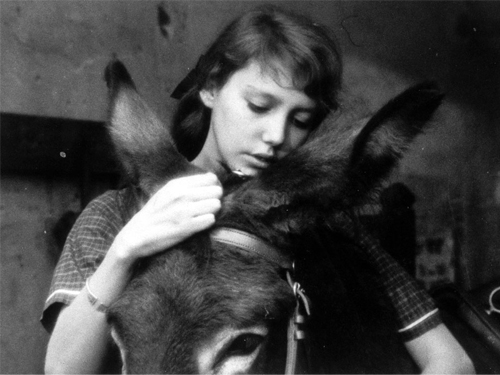
“The world in an hour and a half.”
Jean-Luc Godard
“There is a truly astonishing moment in the film, one where Balthazar arrives at the circus and stops four times in front of the cages, where a lion, then a bear, a monkey, and finally an elephant are locked up: each time Balthazar looks at the animal who looks at him. What is astonishing is that the reciprocity of looks constitutes for us an indecipherable abutment: that they have an exchange, a recognition that testifies to the thoughtfulness or the screams of animals, is perceptible but always inaccessible. It is, for us, without symbol, without the possibility of transmission... This suspension of all possible meaning, appropriate to these looks, redistributes its force throughout the rest of the film.”
Philippe Arnaud1
“Precision rather than beauty – each shot shows only what is absolutely essential, each sequence has been compressed to its most concise form and briefest duration possible. Even so, the length of the shots and cuts are – even for the period when the film was made (1965) – unusually calm. Never do pauses create room for sentimentality, in its simplicity everything gives the impression of having developed naturally and, while being in the service of a rigorous aesthetic concept, is never the victim of the latter. Bresson reportedly intended to personify the seven deadly sins in his characters – but against a declaration such as this can be placed a sentence from his Notes sur le cinématographe: ‘Hide the ideas, but in such a way that they can be found. The most important will be the best hidden’.”
Michael Haneke2
“Bij het lezen van de beschrijving van het begin en het einde van de film kan bij een lezer, die de films van Bresson niet kent, de indruk van ‘poëzie’, van gezochte schoonheid, van pretentieuze stilering binnensluipen. Niets hiervan in deze film: documentaire eenvoud in de kadrering, een bijna manische weigering van het ‘mooie’, namelijk aangename beelden (zoals men ze in zijn eerste films af en toe kon vinden en zoals ze de huidige arthouse cinema ook beheersen, net als in Amerikaanse A-films en reclamespots) – men zou scherp kunnen stellen dat Bresson de uitvinder is van het ‘vuile’ beeld in het domein van de kunstfilm. Naast het altijd voelbare verlangen om de dingen zo duidelijk en eenvoudig mogelijk te tonen, redt een onfeilbaar instinct hem van de gevaren van steriele stilering. Ondanks de nauwkeurige kadrering werken zijn beelden altijd als uitgerafeld, open en paraat voor wanneer de werkelijkheid de regels breekt. Zijn beroemde gevechten met cameramannen, zoals De Santis, bekend om de schoonheid van hun beelden, hebben waarschijnlijk daarin hun oorzaak, denk ik.”
Michael Haneke3
“Films zoals die van Bresson, die afhankelijk zijn van de kracht van suggestie en dus in extreme mate afhankelijk zijn van het reactievermogen en de reactiebereidheid van de toeschouwer, die een kluwen van verbanden, referenties en krachten verbeelden, laten zich onmogelijk herleiden tot een eenduidige, lineaire en onomkeerbare verhouding tussen oorzaak en gevolg. De vrijheid die Bresson zijn publiek laat, stemt overeen met zijn houding als kunstenaar ten opzichte van de werkelijkheid. Wat hij met de vorm van zijn films vastlegt is slechts reliëf; wat men niet ziet is cruciaal en pas in de stilte en sprakeloosheid achter wat men hoort, komt in de eenzaamheid het eigenlijke drama van deze film boven.”
Frieda Grafe4
- 1Philippe Arnaud, “Robert Bresson,” Cahiers du cinéma n° 198, 62–63.
- 2Michael Haneke, “Terror and Utopia of Form: Robert Bresson’s Au hasard Balthazar” in Roy Grundmann (ed.), A Companion to Michael Haneke (Oxford: Wiley-Blackwell, 2010), 565.
- 3Michael Haneke, “Terreur en utopie van de vorm: Verslaafd aan waarachtigheid: Robert Bressons Au hasard Balthazar,” Sabzian, 2013 [Vertaald door Marie Claes en Gerard-Jan Claes van de originele tekst “Schrecken und Utopie der Form - Süchtig nach Wahrhaftigkeit: Eine Kinoerzählung über Robert Bressons Au Hasard Balthazar,” Frankfurter Allgemeine: Zeitung für Deutschland, 6-7 Januar 1995, Nr. 5-6, Bilder und Zeiten, s.p.)
- 4Frieda Grafe, “Au hasard Balthazar van Robert Bresson,” Sabzian, 29 januari 2020.